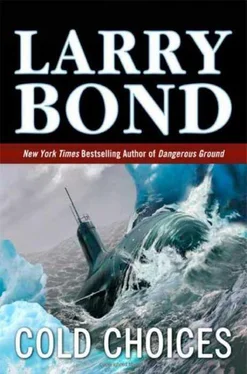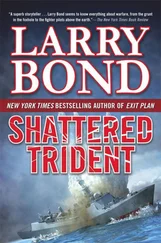PROLOGUE
All the Water in the World
20 August 2008
Groton, Connecticut
Jerry Mitchell braced himself. There was no sensation of a hit, but the force of the inrushing water almost knocked two sailors off their feet. The liquid roar fought with the loudspeaker. “FLOODING IN ENGINE ROOM LOWER LEVEL!” The mechanical voice echoed off the metal bulkheads. He felt the air temperature drop, which gave only the briefest warning when the cold spray reached where he stood.
Jerry fought the urge to rush in and help. Like all submariners, he was trained to run toward the sound of rushing water, but he was also supposed to lead these men. They struggled against the multiple fire-hose jets, but there were enough guys to get the job done. That was one of the first things he looked for, then whether they had the right equipment to plug each leak. But as he watched them work, he relaxed, as much as any submariner could with water lapping around his ankles. His men were on top of it. They knew what to do, and they were working together.
He watched and waited. He suspected they were in for a beating. Sure enough, a rattling BOOM echoed through the space, and the loudspeaker blared “DEPTH CHARGE ATTACK! CLOSE ABOARD!” The reverberation hadn’t even died down when Jerry was drenched by a new jet of water as a pipe behind him cracked. He got out of the way as Petty Officer Robinson ran over with a bandit patch and began fitting it over the pipe. Two other pipe joints had also ruptured, and Jerry heard ETC Hudson, the leading chief petty officer, quickly order people to deal with those new leaks. Turning toward Lieutenant Chandler, his phone talker, Jerry passed on the disheartening news to control.
Engine room lower level was a crowded collection of machinery, piping, and tanks, with catwalks and ladders passing through the tangled compartment. People filled most of the open space — very active people, as they struggled with tools and materials to plug or patch the holes in the pipes. Water continued gushing in, with some of the jets packing enough punch to knock a man over if he wasn’t careful. The solid streams splashed and ricocheted off the jumbled surfaces, throwing spray up in everyone’s face. Even when Jerry could keep the water out of his eyes, the white spray made it difficult to see more than a couple of feet away. And there was the incredible noise. The extra leaks raised the sound to levels reserved for the back end of a jet engine.
In spite of the cold and the wet, the operations department was doing a great job. They worked as a team, looking to Hudson or one of the other senior petty officers for direction. Jerry occasionally heard shouting, of course. They had to raise their voices to be heard over the roaring water, but the tone was calm, reports and directions deliberate.
The water was up to his knees when the auxiliary seawater flange broke. A three-quarter-inch gap opened up where two pipe flanges joined near the overhead. If anyone in the space had been bone dry, this alone would have drenched them. Jerry could see the water level begin to rise more quickly.
Hudson, shaking the water off his face, immediately detailed two men to deal with the flange. Jerry watched them try to bring the pieces back together and his eyes continued upward to a glass-covered booth. Inside, a master chief petty officer, his arms folded, looked down on the chaos and smiled.
Of course, they’d lose in the end. It was impossible to keep USS Buttercup afloat. No matter how many leaks the crew patched, new ones would appear, more water would flood in, and eventually the trainer would “sink.” The real question was, how would his team perform before the inevitable?
It was one thing to sit through damage-control lectures, study diagrams, and practice in a dry, quiet space. The “wet trainer” made it real. You learned how to handle wet tools, how to hold a mattress over a torrent of inrushing water, and how to keep working as water battered your body and the water temperature made your internal organs cluster around your spine, huddling together for warmth.
Most wet trainers looked like the inside of a surface ship’s berthing or engineering spaces. This one, in Groton, Connecticut, was built to look like the inside of a submarine. From the outside, it was just another anonymous concrete brick building on the base, identified by a blue and yellow building number. Inside the two-story building, a mass of catwalks and piping surrounded the incongruous-looking hull section. An 80,000-gallon tank supplied the facility with enough water to fill it to the overhead.
The trainers sat above the space in comfort, controlling which leaks occurred and the water pressure behind them. Although the control booth sat well above the simulated compartment, the windows were fitted with windshield wipers — in use, Jerry noted.
Lieutenant Jerry Mitchell was the navigator/operations officer aboard USS Seawolf (SSN 21), one of the U.S. Navy’s most capable nuclear attack submarines. He still couldn’t believe his luck in landing an assignment on Seawolf, but didn’t trust to luck in doing his job.
Jerry was in charge of the operations department, with enlisted rates like quartermasters, electronics technicians, and information systems technicians working for him. They were not engineering specialists, but all submariners were sensibly required to be experts in fighting flooding and fire, and all other types of “casualties.” That was the less threatening navy term for an accident or equipment failure. Jerry drilled his men hard, maybe even a little harder than they wanted. Now it was paying big dividends.
He’d been aboard for almost six months, and he knew these men well. Like all submariners, they were volunteers: screened, tested, and trained. But that didn’t mean they couldn’t screw up.
Or make poor choices. The broken flange really had dramatically increased the rate the water was rising, and the level was approaching Jerry’s chest. Poor Bishop, the shortest guy in the department, was already treading water. Chief Hudson was trying to cover every leak, but there were just not enough people anymore.
“Chief Hudson!” Jerry was only a few feet away, but in the soggy pandemonium, Hudson couldn’t hear. He was absorbed in wedging a shoring timber properly. He was too close to the problem. Jerry fought the urge to give the orders himself. Instead, he put his hand on Hudson’s shoulder, gently pulling him back from the action. He spoke slowly, forcing calm into the situation. “Worry about the big ones! You can’t plug them all! The drain pumps can handle the smaller leaks!”
He swung his arm around the space, encouraging Hudson to take in the “big picture.” Hudson quickly nodded, droplets of water flying as he did. The electronics technician paused for a moment, considering, before calling out to his team and reassigning some men to the larger leaks.
Jerry knew the simulation would be over soon, but it was never too late to do the right thing. Sure enough, no sooner had Hudson’s men started their new tasks than an amazingly loud klaxon jolted them to a stop. The rush of water faded, taking the urgency with it. It left Jerry and his department standing in neck-deep water. A new sound, a low-pitched whirring, took over as pumps began dewatering the space.
“Well done, Seawolf ops department.” The chief trainer’s voice boomed over the loudspeaker. “Debrief in fifteen minutes.” The trainer’s compliment let a part of Jerry relax as well. Seawolf had a reputation in her squadron and the Atlantic Fleet. This might have been just an exercise, but it was also a chance for Seawolf to shine. Neither Jerry nor his men had any intention of letting their boat down.
Читать дальше












